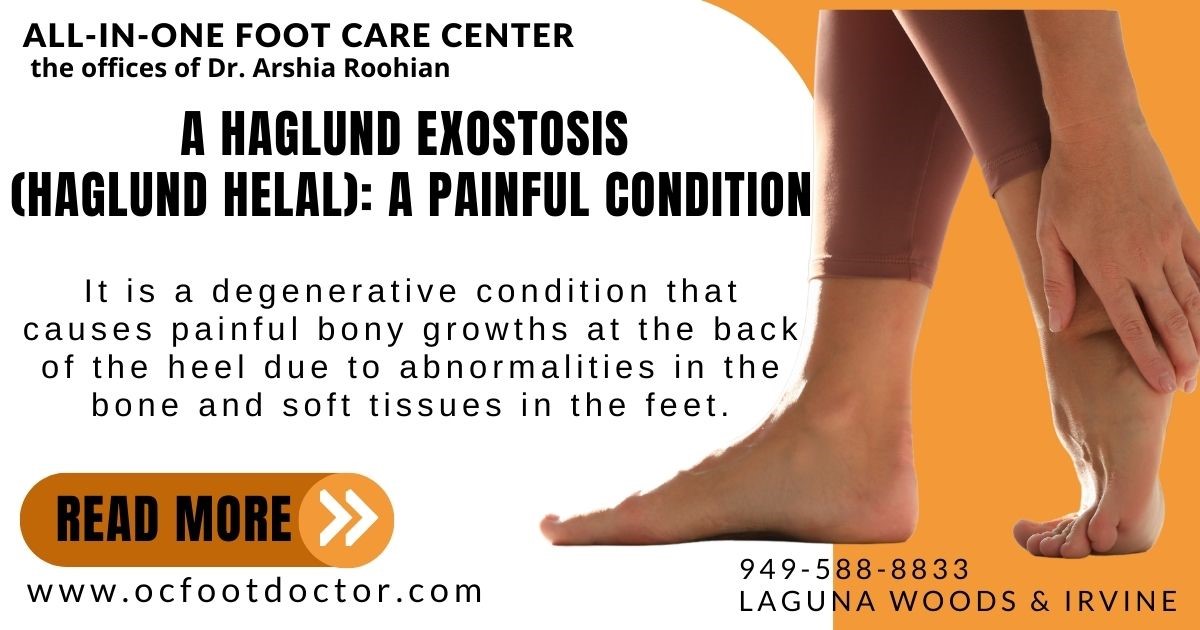A Haglund Exostosis (Haglund Helal): A Painful Condition

Haglund's Deformity: What Is It?
As we stand, walk, run, and jump, our feet bear the weight of the body and transfer power from our lower legs to the rest of us. Our feet have ligaments, tendons, bones, and muscles, which allow us to do complex movements.
It is a degenerative condition that causes painful bony growths at the back of the heel due to abnormalities in the bone and soft tissues in the feet.
There can be chronic cases of foot problems caused by long-term wear and tear, resulting in severe pain and discomfort, as well as restricted mobility for patients.
Deformities caused by Haglund's disease
- Particularly vulnerable are factories.
- Women who wear heels and tight-fitting shoes are more likely to experience uneven load distribution on their feet because of incorrect footwear.
- A lack of proprioception can exacerbate the risk of foot injuries in high-intensity sports such as tennis, rugby, and running.
- Conditions that preexist
Deformity symptoms associated with Haglund's
The symptoms of Haglund's deformity syndrome depend on the severity of the condition and tend to worsen with time and age. The condition affects the heel bone and Achilles tendon in the foot.
Symptoms associated with this condition include:
- The heel bone develops a bony bulge that rubs against the inside of the shoe, causing irritation and discomfort.
- An Achilles tendon that is compressed by a bone is swollen and painful.
- After a long night's sleep or working at a desk, mild cases usually involve episodic pain after prolonged inactivity. Eventually, the pain subsides, but the underlying condition persists. In time, the symptoms become more severe and worsen.
- As a result, patients experience chronic numbness and pain in their feet, as well as severe restrictions in their mobility. Long-term wear and tear, as well as neglect, are able to cause chronic Haglund's syndrome cases.
- Heel spurs can occur when calcium deposits form on the heel bone and turn into bony growths.
Haglund's Deformity: A Diagnosis
If you suspect Haglunds Syndrome, you should seek advice from an orthopedic specialist or general practitioner.
Understanding the individual risk factors is possible through a thorough physical exam and patient history.
Bone growths in the affected area can be located and tracked using sophisticated imaging techniques such as X-rays.
An effective prognosis can be formed based on this information.
Treatment for deformities by Haglund
A conservative approach is used to treat Haglund's syndrome, aimed at relieving the symptoms and preventing its progression.
- Foot Pain Relief Through Lifestyle Changes
- Medical Prescriptions
- Exercises that are beneficial to physiotherapy
- An orthopedic shoe insert for medical use
- Intervention through surgery
- A poorly fitted shoe or incorrect footwear can result in an uneven weight
- Conditions that preexist
You can contact our office at 949-588-8833, or visit our website at https://www.ocfootdoctor.com. Our offices are in Laguna Hills, Irvine, Mission Viejo, Aliso Viejo, Lake Forest, Foothill Ranch, and Costa Mesa.
📲 949-588-8833
🏢 24331 El Toro Rd, Suite 370 Laguna Woods CA 92637
🏢Irvine Medical Arts Building 113 Waterworks Way, Suite 250 Irvine, CA 92618
🌐 https://www.ocfootdoctor.com/
The information contained above is intended for general reference purposes only. It is not a substitute for professional medical advice or a medical exam. Always seek the advice of your physician or other qualified health professionals before starting any new treatment. Health information on this website MUST NOT be used to diagnose, treat, cure or prevent any disease without the supervision of your doctor.


